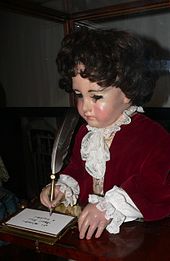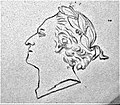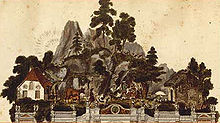Pierre Jaquet-Droz
Pierre Jaquet-Droz (born July 28, 1721 in La Chaux-de-Fonds , † November 28, 1790 in Biel ) was a Neuchâtel clockmaker .
Pierre Jaquet-Droz was born the son of a farmer and watchmaker in La Chaux-de-Fonds (NE) in 1721 and died in Biel in 1790. He attended primary school in his hometown, then the humanistic grammar school with subsequent study of philosophy in Basel . In 1740 Jaquet-Droz turned to watchmaking, which had its center in Le Locle and La Chaux-de-Fonds. In 1758 he traveled to Spain to meet King Ferdinand VI. Pendulum clocks for sale, two of which were provided with an automatic drive. From 1759 he built up an international company in La Chaux-de-Fonds that produced high-quality watches. His son Henri-Louis (1752–1791) also joined his father's company as a watchmaker. His company had branches in London , Paris and Basel. In 1774 the Jaquet-Droz presented three androids to the public, which became a huge success. They are his most famous works and can still be seen in working order in Neuchâtel. Later, Jaquet-Droz and her business partner Jean-Frédéric Leschot began to build prostheses that apparently even worked.
The watchmaker Jaquet-Droz
Pierre Jaquet-Droz was one of the most important clock and automaton manufacturers, who produced truss clocks and pompous pendulum clocks and specialized in automatons of all kinds (including songbird clocks , tobacco boxes with songbirds) and luxury clocks . He developed an automatic winding mechanism for pocket watches.
He is said to have built a clock that he is said to have presented at the Spanish court: when the clock struck, a shepherd played a little melody on the flute and a dog happily approached him. The king was delighted, but Jaquet-Droz said that the dog's friendliness was still one of his least of all virtues, which he would notice immediately if he took one of the apples from the shepherd's basket. The king did so, and the dog supposedly began to bark so lifelike that the king's dog replied and the ladies-in-waiting left the room in a hurry for fear of sorcery. Only the Minister of the Navy was brave enough to stay in the room. When the king asked the black man, who was also on the clock, for the time and he didn't answer, Jaquet-Droz only said that he couldn't speak Spanish ...
The watch brand "Jaquet Droz" , which belongs to the Swatch Group, is named after him.
The three androids (the so-called "Jaquet Droz machines")
Father and son Jaquet-Droz and their collaborators Jean-Frédéric Leschot , Henri Maillardet and Jacob Frisard began building three androids in 1770, which were presented to the public in 1774. The success must have been incredible, at least one contemporary writes that people literally made a pilgrimage there and gardens and squares were full of carriages. For more than a century, the androids toured Europe and could be viewed for an entrance fee. The figures are approx. 70 cm high, heads, arms and eyes are movable. They are dressed in courtly contemporary fashion and look very young, if not like children. They are probably some of the most beautiful androids ever created. Jacques de Vaucanson , himself a pioneer and master of machine construction, is said to have exclaimed to Henri-Louis Jacquet-Droz after their visit: "Young man, you start where I intend to finish!"
The writer
When the scribe is started, he dips the quill into the ink, shakes it off gently, puts his hand on the top of the page and stops. When another lever is operated, it begins to write. He stops like a real writer, pays attention to the up and down strokes, the spaces and the lines (!), Puts a point at the end and stops again.
The writer can write any text with up to 40 characters. This is entered on a disc with exchangeable cams. (This means that, for example, when a high-ranking visitor comes, the clerk can also write a text related to this visitor; this is said to have been the case at the end of the visit to Mitterrand.) “ Depending on the height of the cams, a cylinder is also included a set of cams that contains the coding of the individual letters. Three cams each move the hand up and down, back and forth, right and left. The dimensions of the cams used for programming the text must adhere to very tight tolerances. The machine is therefore quite prone to errors. That was probably a constructive concession to the desire to accommodate all of the mechanics in the figure. "
Some authors see the scribe as a forerunner of today's computers, because it has a program (the disk with which the text is set) and a memory (the cam disks that represent the individual letters).
The drawer
The draftsman's mechanism is controlled by a set of cams on which the drawing program is located. With three interchangeable cam disk sets, four different drawings can be made:
- a portrait of Louis XV and the dog "Toutou" (both pictures on a roller),
- King George of England and his wife,
- the romantic motif of the chariot pulled by a butterfly.
The organist
The musician is controlled by a pin roller and associated cam disks with which the fingers of the hands are moved. The figure strikes the keys of a kind of organ with the sound of a flute. She can play five different pieces composed especially for her.
The Jaquet-Droz family grotto
In the book Die Jaquet-Droz and Leschot, written by Charles Perregaux and F.Louis Perrot, the authors say: "We know the three androids from 1774, but we have not yet mentioned a fourth automatic machine built in the same age, which is extremely interesting and complex had to be: "The Grotto".
A poster printed in Lyon on January 3, 1784 on the occasion of a machine presentation, describes "the grotto" as follows: "A landscape in Switzerland where you can see: cliffs, a sheep farm, a hut, a mill, a waterfall and a stream , a calf that is suckled by a cow, goats and sheep that graze, grumble and bleat, and a dog that watches over the herd. A farmer sitting on a donkey comes out of his hut, walks through the countryside to himself Mill, and soon after he goes back on foot, leading his sack-laden donkey, and a dog barks when he goes by.
A shepherd comes out of a cave in a rock, takes the flute to his mouth, plays a prelude that echoes; then approaches the awakening shepherdess, who takes her guitar and accompanies her shepherd. The front of this piece depicts a ground floor enclosed by the facade of a building, under the gate of which one sees a peasant woman playing various minuets on a dulcimer, while two young women dance with grace and precision. There are also waterfalls and fountains, the play of which creates an illusion, and an aviary where different birds can be heard chirping. "
It is likely that such an advanced piece of work could never be repaired, it must have been neglected and left to decay in a poor dwelling. "
The construction of prostheses
In addition to their other activities, Jaquet-Droz and its business partner Jean-Frédéric Leschot began manufacturing prostheses for amputated limbs. Jean-Frédéric Leschot specialized in this activity and his reputation in this field earned him numerous assignments, including from abroad.
Unlike the prostheses customary at the time, which had more aesthetic value, these were apparently even functional, i.e. H. Knees could be bent and objects could be held.
See also
literature
- Roland Carrera et al. a .: androids. The Jaquet-Droz machines (“Les Androïdes”). Edition Scriptar, Lausanne 1979, ISBN 2-88012-017-9 .
- Comité des Fêtes (ed.): Les œuvres des Jaquet-Droz. Montres, pendules et automates (musées et collections privées) . Comité des fêtes du 250e anniversaire de la naissance de Pierre Jaquet-Droz, La Chaux-de-Fonds 1971 (Festschrift).
- Charles Perregaux: Les Jaquet-Droz et leurs automates , Neuchâtel, 1906
- Charles Perregaux and François-Louis Perrot: Les Jaquet-Droz et Leschot , Neuchâtel, 1916
- Alfred Chapuis and Édouard Gélis: Le monde des automates , Paris, 1928
- Alfred Chapuis and Édmond Droz: Les automates, figures artificielles d'hommes et d'animaux , Neuchâtel, 1949
- Éliane Maingot: Les automates , Paris, 1959
- Roland Carrera, Dominique Loiseau and Olivier Roux: Androïdes. Les automates Jaquet-Droz , Lausanne, 1979
- Jean-Claude Beaune: L'automate et ses mobiles , Paris, 1980
- André Tissot: Voyage de Pierre Jaquet-Droz à la Cour du Roi d'Espagne 1758-1759 , Neuchâtel, 1982
- Annette Beyer: Fascinating World of Automata , Munich, 1983
- Chris Hables Gray (Ed.): The Cyborg Handbook , Routledge, New York 1995
- Marc Vanden Berghe: Henri-Louis Jaquet-Droz and Pierre Jaquet-Droz in Biographies Neuchâteloises , tome I, Hauterive, Attinger, 1996
- Jürgen Söring and Reto Sorg: Die Androïden: zur Poetologie des Automaten , Bern, Peter Lang, 1996
- Eduard Blatzhoff: The Neuchâtel automatons and their history. In: Schweizer Illustrierte , Vol. 10, 1906, pp. 528-530.
Individual evidence
- ^ Homepage Historisches Lexikon der Schweiz, 1998–2007, as of January 6, 2008
- ↑ a b c d Henner Schneider, Fb Informatik, FH Darmstadt on the homepage of the Ken Whyld Association (kwabc.org), Amsterdam, as of January 6, 2008
- ↑ a b Homepage of the watch shop, association of watch enthusiasts, as of January 6, 2008
- ↑ THE MIRROR OF LITERATURE, AMUSEMENT, AND INSTRUCTION. VOL. 10, No. 275. SATURDAY, SEPTEMBER 29, 1827. " Chapter Kew Palace, Section" Magical Clocks
- ↑ a b c Homepage Automates Anciens, engl. Version as of January 6, 2008
- ^ André Soriano (Hr.): Mechanical characters from bygone times. Sauret, Paris (?) 1985
- ↑ Baumunk / Kallinich / Sänger (eds.): "The robots are coming! Man - machine - communication". 2007
- ↑ a b Homepage Automates Anciens, German version, as of January 6, 2008
Web links
- Anne Jeanneret-de Rougemont: Jaquet-Droz, Pierre. In: Historical Lexicon of Switzerland .
- Search for Pierre Jaquet-Droz in the SPK digital portal of the Prussian Cultural Heritage Foundation
- Text by Henner Schneider, Department of Computer Science, FH Darmstadt (PDF file; 17 kB)
- Uhrenhanse Homepage of the Uhrenhanse
- Automates anciens German
- Automates anciens English version, many links work here that did not work on the German site (at least not with Opera)
- Video of the three androids
| personal data | |
|---|---|
| SURNAME | Jaquet-Droz, Pierre |
| BRIEF DESCRIPTION | Swiss watchmaker |
| DATE OF BIRTH | July 28, 1721 |
| PLACE OF BIRTH | La Chaux-de-Fonds |
| DATE OF DEATH | November 28, 1790 |
| Place of death | Bienne |









